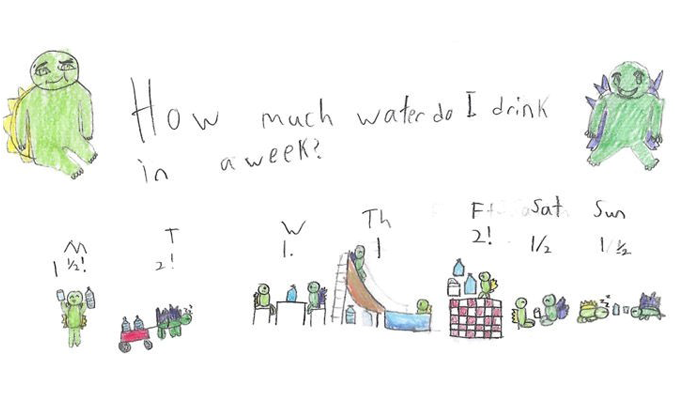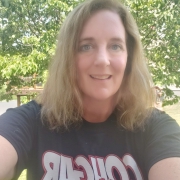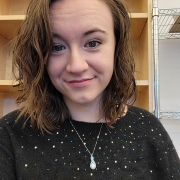 Lesson Example #1 Overview: In this lesson, students can choose between six significant habitat changes including wildfires, deforestation, city growth, sea levels rising, glaciers melting, and coral bleaching. Once they choose their topic, they will use EarthTime to analyze the data in different areas around the world so they can choose an area which they feel is impacted the most by environmental justice to complete a larger unit project.
Lesson Example #1 Overview: In this lesson, students can choose between six significant habitat changes including wildfires, deforestation, city growth, sea levels rising, glaciers melting, and coral bleaching. Once they choose their topic, they will use EarthTime to analyze the data in different areas around the world so they can choose an area which they feel is impacted the most by environmental justice to complete a larger unit project.
Teacher: Tori Lojek, STEAM, Grades 3-5
Lesson Plans Grade 5 (includes unit plan): Understanding Human Impact on the Environment using Data Visualization Techniques through EarthTime
Lesson Demonstration Video: Link
Lesson Overview & Slide Deck: Link
 Lesson Example #2 Overview: Students engage in an activity called Looking Ten Times Two in which they work independently then merge into group work. Students also engage in a data talk and use EarthTime to discover the constant burning fire in Braddock, PA and the environmental justice implications. Students will build connections between air pollution in Pittsburgh and surrounding industries. Students observe and capture data from historical photographs and work collaboratively with peers to understand the connection between the photographs and issues of Environmental Justice.
Lesson Example #2 Overview: Students engage in an activity called Looking Ten Times Two in which they work independently then merge into group work. Students also engage in a data talk and use EarthTime to discover the constant burning fire in Braddock, PA and the environmental justice implications. Students will build connections between air pollution in Pittsburgh and surrounding industries. Students observe and capture data from historical photographs and work collaboratively with peers to understand the connection between the photographs and issues of Environmental Justice.
Teacher: Lynette Lortz, Computer Science, Grades 8-12
Lesson Plan Grade 8: Using Visualizations to Inspire Curiosity: How does our environment affect us?
Lesson Demonstration Video: Link
Lesson Overview & Slide Deck: Link
 Lesson Example #3 Overview: In this unit, students will have the opportunity to collect audio and visual assets through connecting with Nature. They will use those assets and coding skills to create multimedia/multimodal websites to share their observations and experiences with others. They will also make explicit connections between the computational thinking activities involved with coding their observations in Nature, and Environmental Justice through narrative story telling.
Lesson Example #3 Overview: In this unit, students will have the opportunity to collect audio and visual assets through connecting with Nature. They will use those assets and coding skills to create multimedia/multimodal websites to share their observations and experiences with others. They will also make explicit connections between the computational thinking activities involved with coding their observations in Nature, and Environmental Justice through narrative story telling.
Teacher: Shad Wachter, Technology Literacy, Grades 3-5
Lesson Plan Grade 5 (includes unit plan): Coding Nature
Lesson Demonstration Video: Link
Lesson Overview & Slide Deck: Link




 Lesson Example #2 Overview: Students will learn what the meaning of Environmental Justice is, then as a whole group decide on what community issue they would like to focus on. After the group has agreed upon an overarching issue they will discuss how they will create a plan that will achieve change.
Lesson Example #2 Overview: Students will learn what the meaning of Environmental Justice is, then as a whole group decide on what community issue they would like to focus on. After the group has agreed upon an overarching issue they will discuss how they will create a plan that will achieve change. Lesson Example Overview: Students are introduced to many different types of bees and their importance to the survival of plants and animals and make connections with nature and environmental justice from the data they collect throughout the lessons.
Lesson Example Overview: Students are introduced to many different types of bees and their importance to the survival of plants and animals and make connections with nature and environmental justice from the data they collect throughout the lessons. Lesson Example #1 Overview: In this project unit, students will research topics related to their main environment, the city of Pittsburgh. Students are expected to research topics such as Pittsburgh green spaces, reducing our carbon footprint, lead in the water and more as they look in their community and try to effect change. Students will participate in data collection from their community to help drive a persuasive letter written to Mayor Ed Gainey to help effect change in the community. They will use their data and data analysis tools such as scatter plots or frequency tables to support their argument/position. They will also participate in audio production of their argument either in the form of a recorded performance of their letter, or a roundtable discussion of environmental topics they see affecting their community.
Lesson Example #1 Overview: In this project unit, students will research topics related to their main environment, the city of Pittsburgh. Students are expected to research topics such as Pittsburgh green spaces, reducing our carbon footprint, lead in the water and more as they look in their community and try to effect change. Students will participate in data collection from their community to help drive a persuasive letter written to Mayor Ed Gainey to help effect change in the community. They will use their data and data analysis tools such as scatter plots or frequency tables to support their argument/position. They will also participate in audio production of their argument either in the form of a recorded performance of their letter, or a roundtable discussion of environmental topics they see affecting their community. Lesson Example #2 Overview: Students research food systems, make a plan, apply for funding through Chipotle’s Sustainability Challenge, execute the plan, and submit it for prize money.
Lesson Example #2 Overview: Students research food systems, make a plan, apply for funding through Chipotle’s Sustainability Challenge, execute the plan, and submit it for prize money. Lesson Example #3 Overview: In this lesson Environmental Justice & Data Science Overview and Life Connection students are introduced to the basics of environmental justice and how data science is used to inform it. They are also given an opportunity to make connections to personal, local, and nationwide injustices.
Lesson Example #3 Overview: In this lesson Environmental Justice & Data Science Overview and Life Connection students are introduced to the basics of environmental justice and how data science is used to inform it. They are also given an opportunity to make connections to personal, local, and nationwide injustices. Lesson Example #1 Overview: In this lesson, students can choose between six significant habitat changes including wildfires, deforestation, city growth, sea levels rising, glaciers melting, and coral bleaching. Once they choose their topic, they will use EarthTime to analyze the data in different areas around the world so they can choose an area which they feel is impacted the most by environmental justice to complete a larger unit project.
Lesson Example #1 Overview: In this lesson, students can choose between six significant habitat changes including wildfires, deforestation, city growth, sea levels rising, glaciers melting, and coral bleaching. Once they choose their topic, they will use EarthTime to analyze the data in different areas around the world so they can choose an area which they feel is impacted the most by environmental justice to complete a larger unit project. Lesson Example #2 Overview: Students engage in an activity called Looking Ten Times Two in which they work independently then merge into group work. Students also engage in a data talk and use EarthTime to discover the constant burning fire in Braddock, PA and the environmental justice implications. Students will build connections between air pollution in Pittsburgh and surrounding industries. Students observe and capture data from historical photographs and work collaboratively with peers to understand the connection between the photographs and issues of Environmental Justice.
Lesson Example #2 Overview: Students engage in an activity called Looking Ten Times Two in which they work independently then merge into group work. Students also engage in a data talk and use EarthTime to discover the constant burning fire in Braddock, PA and the environmental justice implications. Students will build connections between air pollution in Pittsburgh and surrounding industries. Students observe and capture data from historical photographs and work collaboratively with peers to understand the connection between the photographs and issues of Environmental Justice. Lesson Example #3 Overview: In this unit, students will have the opportunity to collect audio and visual assets through connecting with Nature. They will use those assets and coding skills to create multimedia/multimodal websites to share their observations and experiences with others. They will also make explicit connections between the computational thinking activities involved with coding their observations in Nature, and Environmental Justice through narrative story telling.
Lesson Example #3 Overview: In this unit, students will have the opportunity to collect audio and visual assets through connecting with Nature. They will use those assets and coding skills to create multimedia/multimodal websites to share their observations and experiences with others. They will also make explicit connections between the computational thinking activities involved with coding their observations in Nature, and Environmental Justice through narrative story telling. Lesson Example #1 Overview: In this lesson, students will be introduced to the Smell Pittsburgh website and app. The students will analyze the data collection process and visualization used by Smell Pittsburgh. Students will download selected data and create their own visualizations in order to make recommendations for intervention and/or activism. Smell Pittsburgh is an application developed in Pittsburgh that allows its citizens to report pollution by foul odors.Teacher: Holly Plank, Graduate Student Researcher and PhD student, University of PittsburghLesson Plan Grade 6-8:
Lesson Example #1 Overview: In this lesson, students will be introduced to the Smell Pittsburgh website and app. The students will analyze the data collection process and visualization used by Smell Pittsburgh. Students will download selected data and create their own visualizations in order to make recommendations for intervention and/or activism. Smell Pittsburgh is an application developed in Pittsburgh that allows its citizens to report pollution by foul odors.Teacher: Holly Plank, Graduate Student Researcher and PhD student, University of PittsburghLesson Plan Grade 6-8:  Lesson Example #1 Overview: Students will collect data on their households’ habits related to recycling, water consumption, consumption of resources, travel, etc. After analyzing the data, students will create story boards to design an app to address the environmental problem they explored. Students will use MIT app inventor to code interactive apps for a designated audience.
Lesson Example #1 Overview: Students will collect data on their households’ habits related to recycling, water consumption, consumption of resources, travel, etc. After analyzing the data, students will create story boards to design an app to address the environmental problem they explored. Students will use MIT app inventor to code interactive apps for a designated audience.